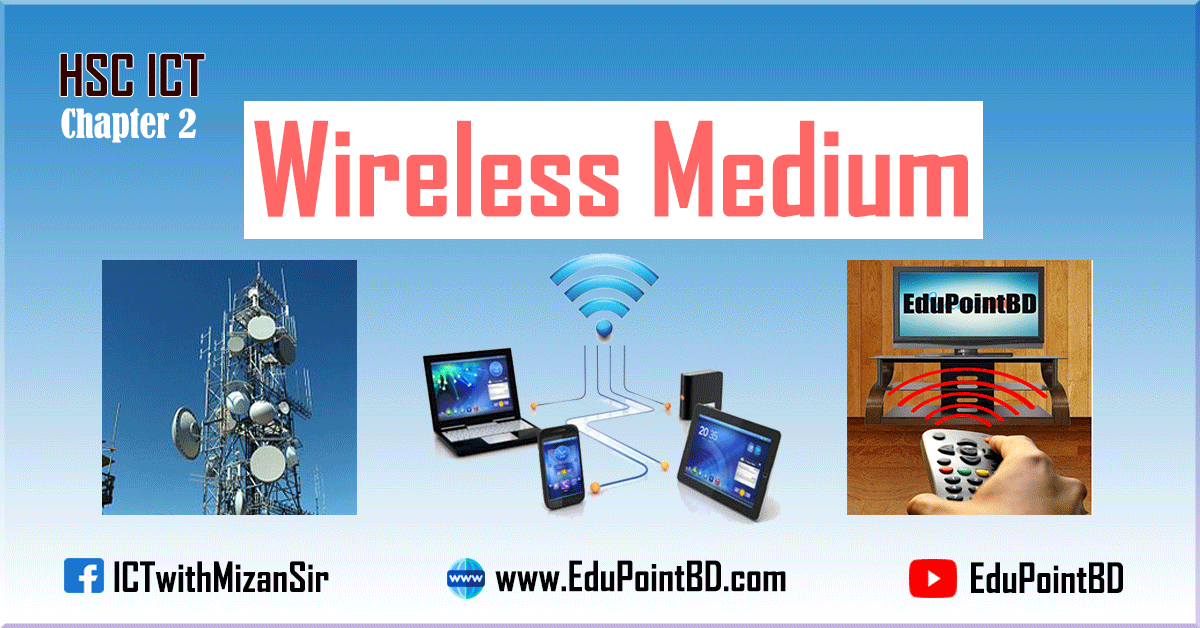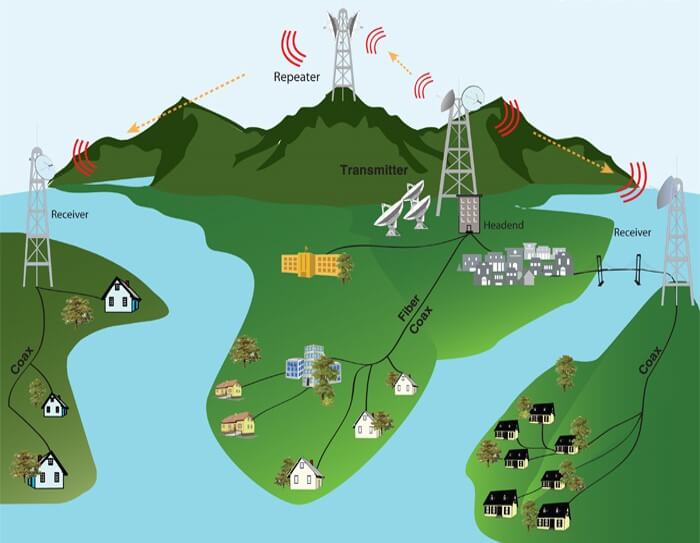
At the end of this lesson-
1. You will be able to explain the concept of wireless data communication medium.
2. You will be able to describe the types of wireless medium.
3. You will be able to describe radio wave, microwave, Infrared.
Go for Bangla Version
What is Wireless Medium?
- Radio wave
- Microwave
- Infrared
The medium used to exchange information in a wireless communication system is called Wireless or Unguided Medium. In wireless communication systems, information is transmitted over long distances with the help of electromagnetic waves without using any physical medium. In this case the antenna plays an important role in data exchange. This electromagnetic wave is a kind of light ray. In unguided media, air is the media through which the electromagnetic energy can flow easily.
The wave length of Electromagnetic Wave(EMW) can be 10-14 meter (microscopic) to 10+14 meter (as large as several football field). The total range of wavelength of Electromagnetic Wave(EMW) is called Electro Magnetic Spectrum.
This Electro Magnetic Spectrum is divided into several smaller range according to the characteristics. Such as –Radio wave, Microwave, Infrared, Light wave, Ultraviolet ray, X-ray and Gamma Ray.

The following three types of waves are used in wireless communication systems. E.g.
1. Radio Wave
2. Microwave
3. Infrared
How Data is Transmitted using Electro Magnetic Wave:
Data is transmitted using EMW through modulation. There are two types of modulation.
1. Analog modulation
- Amplitude Modulation
- Frequency Modulation
- Phase Modulation
2. Digital modulation
Point-to-point and point-to-multipoint communication can be done with the help of electromagnetic waves. In this case two types of antennas are used.
- Transmitter Antenna
- Receiver Antenna
The transmitter antenna converts the electrical signal into electromagnetic waves that can reach the destination through air, water and space. The receiver antenna converts electromagnetic waves into electrical signals.
Types of antennas
There are two types of antennas depending on how the signal is transmitted or received.
- Directional Antenna
- Omni Directional Antenna
Directional Antenna: This type of transmitter antenna transmits the wave to one direction like the light of a flashlight and the receiver antenna has to be in the line of sight to receive the wave.
Omni Directional Antenna: This type of transmitter antenna transmits the wave around like the light of a bulb and the receiver antenna can receive the wave from all directions.
Wireless or Unguided Medium(Non visible light for data communication):
Unguided transmission is broadly classified into three categories:
- Radio Wave
- Micro Wave
- Infrared
What is Radio Wave?
Radio waves are the electromagnetic waves having frequency range from 3 KHz to 300 GHz that are transmitted in all the directions of free space. Radio waves are omnidirectional, i.e., the signals are propagated in all the directions. In the case of radio waves, the sending and receiving antenna are not aligned, i.e., the wave sent by the sending antenna can be received by any receiving antenna. The wave length is 1 mm to 100 km. In communication 10 KHz to 1GHz frequency range is used.
It can be propagated in three form. Such as:
- Surface Wave
- Sky Wave
- Space Wave
Advantages of Radio transmission:
- This wave can penetrate and travel through building. Thus it is used for both indoor and outdoor communication.
- The transmitter and receiver do not need to be in the line of sight.
- Radio waves are not absorbed by the atmosphere, so they are slightly affected by the atmosphere.
Disadvantages of Radio transmission:
- Low frequency is used in radio wave transmission, it is not possible to transmit huge amount of data simultaneously.
- Radio waves are harmful to health.
Applications of Radio waves:
- A Radio wave is useful for multicasting when there is one sender and many receivers.
- An FM radio, television, cordless phones are examples of a radio wave.
- Radio transmission is mainly used for wide area networks and mobile cellular phones.
What is Microwaves?
Microwaves are the electromagnetic waves having frequency range from 300 MHz to 300 GHz. The wave length of microwave is 1 mm to 1 m. Microwave travels in straight path and it cannot pass through objects. Thus for communication, it needs line of sight.
Characteristics of Microwave:
Frequency range: The frequency range of microwave is from 300 MHz to 300 GHz.
Bandwidth: It supports the bandwidth from 1 to 10 Mbps.
Short distance: It is inexpensive for short distance.
Long distance: It is expensive as it requires a higher tower for a longer distance.
Attenuation: Attenuation means loss of signal. It is affected by environmental conditions and antenna size.
Advantages of Microwave:
- Microwave transmission is cheaper than using cables.
- It is free from land acquisition as it does not require any land for the installation of cables.
- Microwave transmission provides an easy communication in terrains as the installation of cable in terrain is quite a difficult task.
- Communication over oceans can be achieved by using microwave transmission.
Disadvantages of Microwave transmission:
- Eavesdropping: An eavesdropping creates insecure communication. Any malicious user can catch the signal in the air by using its own antenna.
- Out of phase signal: A signal can be moved out of phase by using microwave transmission.
- Susceptible to weather condition: A microwave transmission is susceptible to weather condition. This means that any environmental change such as rain, wind can distort the signal.
- Bandwidth limited: Allocation of bandwidth is limited in the case of microwave transmission.
Types of Microwave
Microwaves are of two types. Such as:
- Terrestrial Microwave
- Satellite Microwave

What is Terrestrial Microwave?
In this kind of communication technology transmitter and receiver is set up on the ground at the line of sight. Microwaves are unidirectional as the sending and receiving antenna is to be aligned, i.e., the waves sent by the sending antenna are narrowly focused. It works on the line of sight transmission, i.e., the antennas mounted on the towers are the direct sight of each other.

What is Satellite Microwave?
A satellite is a physical object that revolves around the earth at a known height. Satellite communication is more reliable nowadays as it offers more flexibility than cable and fiber optic systems. We can communicate with any point on the globe by using satellite communication.

How Does Satellite work?
The satellite accepts the signal that is transmitted from the earth station, and it amplifies the signal. The amplified signal is re-transmitted to another earth station.
Advantages of Satellite Communication:
- The coverage area of a satellite microwave is more than the terrestrial microwave.
- The transmission cost of the satellite is independent of the distance from the center of the coverage area.
- Satellite communication is used in mobile and wireless communication applications.
- It is easy to install.
- It is used in a wide variety of applications such as weather forecasting, radio/TV signal broadcasting, mobile communication, etc.
Disadvantages of Satellite Communication:
- Satellite designing and development requires more time and higher cost.
- The Satellite needs to be monitored and controlled on regular periods so that it remains in orbit.
- The life of the satellite is about 12-15 years. Due to this reason, another launch of the satellite has to be planned before it becomes non-functional.
What is Infrared Wave?
Infrared waves are the electromagnetic waves having frequency range from 300 GHz to 400 THz. The wave length if infrared is 750 nm to 1 mm.
Characteristics of Infrared:
- It supports high bandwidth, and hence the data rate will be very high.
- Infrared wave can not penetrate through wall or hard object. Thus it is limited in indoor use.
- An infrared communication provides better security with minimum interference.
- Infrared communication is unreliable outside the building because the sun rays will interfere with the infrared waves.
Application of Infrared :
It is used for short-range communication such as data transfer between two cell phones, TV remote operation, data transfer between a computer and cell phone resides in the same closed area.
Importance of wireless media:
1. Wireless media is useful for data communication between remote and inaccessible places.
2. Wireless media is more useful for data communication between portable devices (mobiles, laptops, tablets, etc.).
Lesson Evaluation-
Knowledge Based Questions:
b) What is electromagnetic spectrum?
b) What is radio wave?
b) What is microwave?
b) What is Infrared?
Comprehension Based Questions:
b) In which type of communication system transmitter and receiver remain in line of sight?
b) Why is microwave or infrared not used in mobile phone?
b) Why radio wave is used in TV remote at present instead of infrared?
b) Explain the wave used in satellite.
Creative Questions:
Read the following stem and answer the questions:
ICT dependent knowledge and technology is leading people on the path to prosperity. Arif learned about a medium of communication where sound as well as moving pictures can be sent. However, since the data cannot move in a crooked way, it is necessary to install a tower on a tall building with a frequency of 300MHz-300GHz. It was later combined with a newly invented technology that connected one continent to another through the ocean floor.
c) Explain the 1st medium of the stem.
Read the following stem and answer the questions:
Nusaiba wanted to connect three computers in her flat’s three rooms to a network so that the printer connected to the computer in her father’s room could be used by everyone in the family. Her father’s advice was to use any cable medium and her mother’s advice was to use any wireless media in setting up the network. However, Nusaiba occasionally exchanges information with his mobile phone and his mother’s mobile phone using a technology of IEEE 802.15 standard.
c) Explain the medium of the technology used by Nusaiba to exchange information as mentioned in the stem.
d) According to you Nusaibar should take whose advice to set up a network of the stem? Argue for the answer.
Multiple Choice Questions:
1. Which technology is needed to overcome the disadvantages of microwave technology?
a) Infrared b) GPS c) Radio Wave d) Satellite
2. GEO satellite to be placed in a specific orbit in which distance from the ground?
a) 12000 Km b) 22000 Km c) 27000 Km d) 36000 Km
3. Which medium is used in television remote control?
a) Infrared b) Radio wave c) Microwave d) Bluetooth
Read the following stem and answer question no 4 and 5:
Mohana noticed that towers of various mobile companies have been placed on the tallest buildings in their area. Even in the open wilderness the towers are placed far away, with no barriers in the middle. An antenna with some equipment has been placed on a building.
4. What kind of medium do the tall towers of the stem use?
a) Radio wave b) Terrestrial microwave c) Infrared d) Satellite microwave
5. The aerial system of the stem is used-
i. In the case of sending signals on television
ii. Observing the latest weather conditions
iii. In the case of intercontinental telephone calls
Which one is correct?
a) i & ii b) i & iii c) ii & iii d) i, ii & iii
Written by,
- Mizanur Rahman (Mizan)
- Lecturer in ICT, Shaheed Bir Uttam Lt. Anwar Girls’ College , Dhaka Cantonment
- Founder & Author at www.edupointbd.com
- Software Engineer at mands IT
- Former Lecturer in ICT, Cambrian College, Dhaka
- Contact: 01724351470
